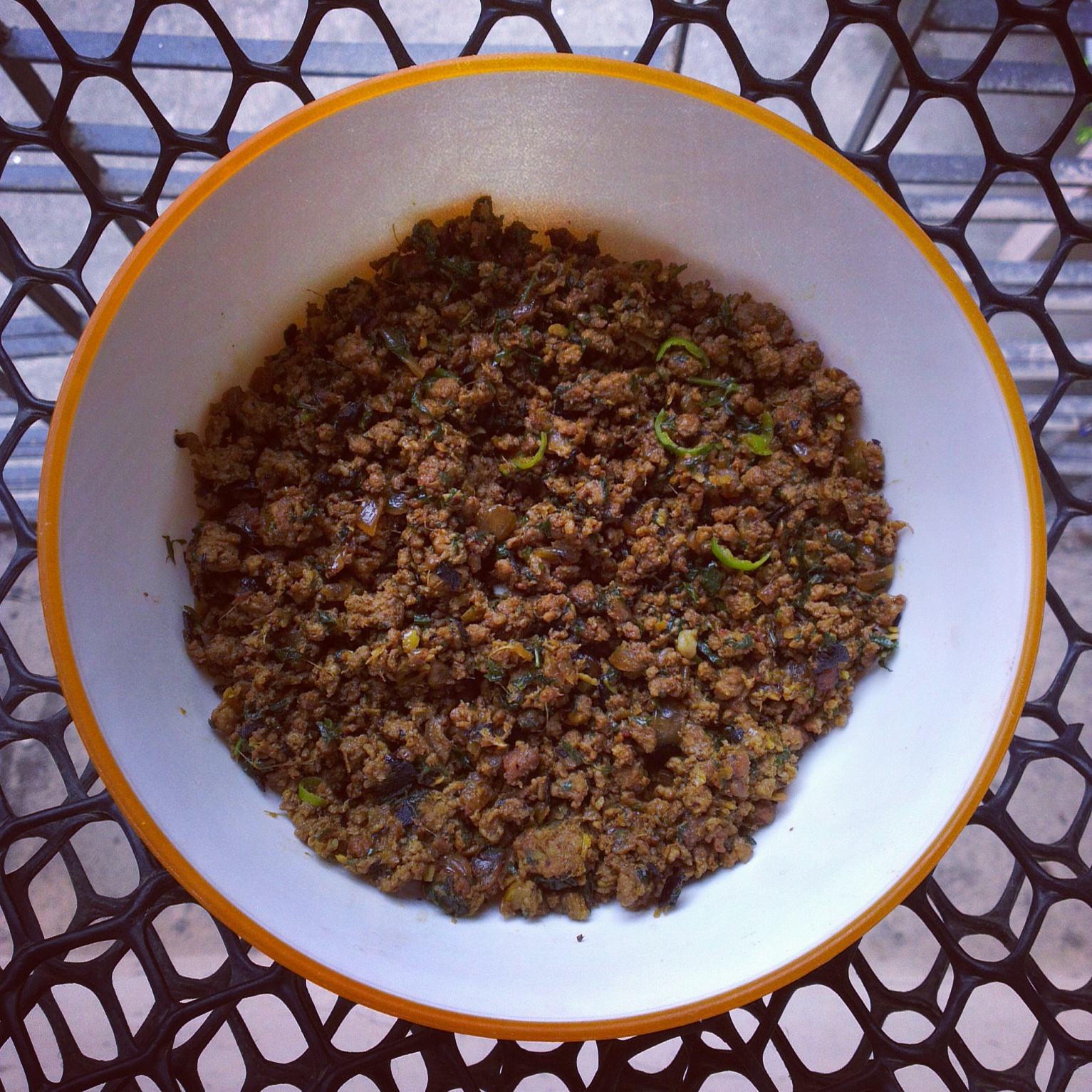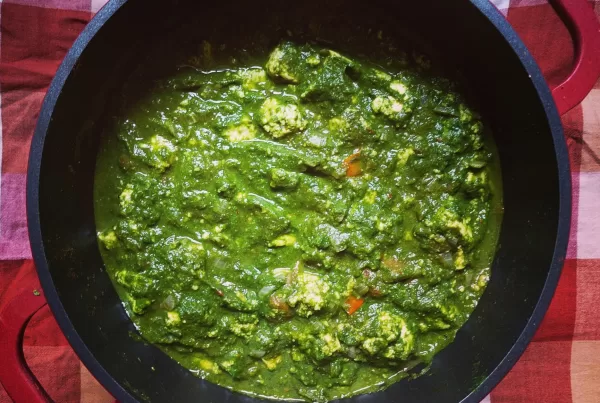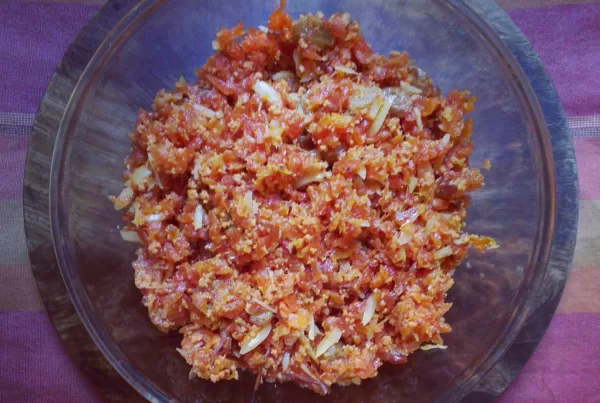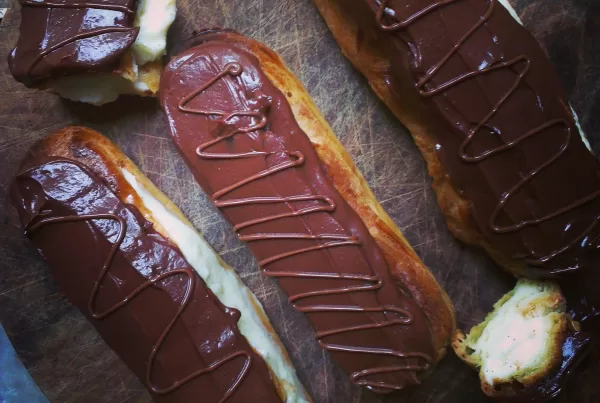It’s almost been a whole year since I executed by baked samosa experiment. This Sunday, I decided to revisit the samosa in a non-vegetarian, rather meaty-muttony variant. This recipe is a little different from the traditional method only in its addition of honey to caramelise the onions in the first steps of the mutton preparation, and vinegar towards the end. I thought these two flavours would work well as effective counterweights to the umami of mutton. The green chillies contribute the most towards the heat, though you could easily ramp this up or down as per your own heat threshold. This recipe is for a moderately spicy samosas.
Because of the consistency of the mince, it tends to pack in more firmly than a vegetarian, potato-based variety, which is why the assembly and folding of the pastry is slightly different in this method. The end result is a more flatter, two dimensional triangular sort of samosa. You could also go the other way and fold it into the regular pyramidal variety, but I have a feeling the lack of internal cohesion might result in the samosas sagging or losing shape as the butter melts and pastry becomes momentarily soft, and prone to shrinkage.
I also attempted a new method of cutting the butter into the flour for the pastry this time around. I used a hand blender with a processor/chopper attachment— the one with a twin curved blade in a little plastic container. It wasn’t big enough to fit all the flour and butter in, so I had to do it in two batches. It did however do the job much quicker than the pastry blender-hand-cut method I usually follow. This is especially good for making pastry on hot days, since faster-made pastry has less time to melt and mix with the flour.
This samosa is actually an easier one than the vegetarian, potato based one (mostly because you don’t have to spend any time boiling potatoes here), so don’t let any trepidations about it’s complexity or difficulty level keep you from attempting it.
Health wise, this is probably only a little healthier than the standard deep-fried variety, because of all the butter that goes into making the pastry, which also yields a slightly heavier than usual samosa. I would however still recommend making this (and consuming it in moderation, if such a thing was possible), just to enjoy the sheer pleasure of biting into explosively flaky, crunchy butter-based pastry with a kiss of salt, married to the umami viscera of of the minty mutton filling inside.
The Recipe
Ingredients
For the crust
105g Atta (whole wheat flour)
105g Maida (all purpose flour)
150g butter
½tsp salt
1tsp ajwain (carom seeds)
90ml ice cold water
For the filling
Yields ten medium-sized samosas.
Method
- Cut the butter into tiny cubes and freeze for about two hours or more.
- Mix the flours and salt in a large bowl.
- Add the butter to this in three parts and cut the butter into it using a pastry blender, food processor or by rubbing it into the flour with fingers (if you don’t have hot hands) till it reaches a coarse meal consistency
- Pour the ice cold water into this to bring the mixture together. Wrap in clingwrap and flatten into a disc. Let this rest in the fridge for at least an hour.
- Dice the onions fine and sauté the onions in cooking oil, with honey, until thoroughly browned and caramelised.
- Add the ginger garlic paste and cook for a minute, before adding the spices (coriander powder, ground pepper, red chilli powder, cumin and turmeric) and cooking till it starts to release oil.
- Add the minced meat in bits till completely mixed with the onion-spice mix.
- Once the mince colours, add the vinegar and garam masala, followed by the chopped up mint and coriander leaves. Cook for around five minutes more. Set aside and cool.
Assembly
- Divide the pastry dough into five equal parts and roll them into balls with your hands.
- Roll each ball out into a disc, about 2mm thin.
- Cut the disc into two halves.
- Spoon the mince into the middle part of the half-circles of rolled out pastry dough and brush (or use your fingertips) to paint the inside edges of the pastry with water.
- Gently fold one side of the semicircle (imagine a half circle divided into three equal triangular parts; the filling goes into the middle part, and the other sides are folded over this), making sure to pinch the edges and corners to seal them. Make sure there aren’t any air pockets inside.
- Freeze for about half an hour, while the oven pre-heats to 180ºC.
- Bake for 20 minutes, and then flip them over to let the bottoms also bake for an additional 20 minutes. Keep an eye on the pastry, it should turn a golden brown and shouldn’t overcook and become hard.









Thanks for the cool informative post. Keep up the great work 🙂
Hi, I think your page was amazing.
Take it in you hand and fold the water applied straight edge over the back of the other straight edge to make a cone. Press it lightly to seal the edge. Since we have brushed with little water, it would be easy to seal them.